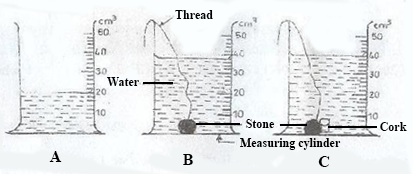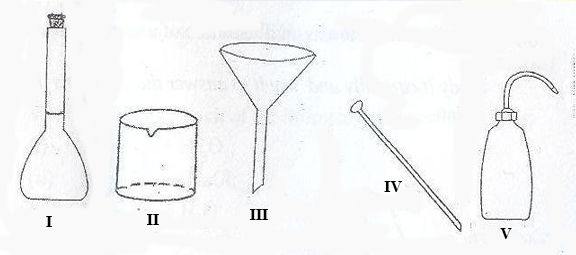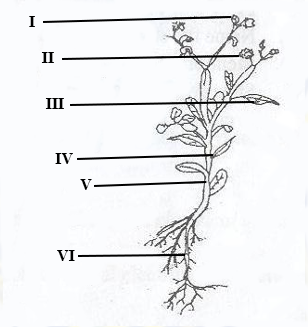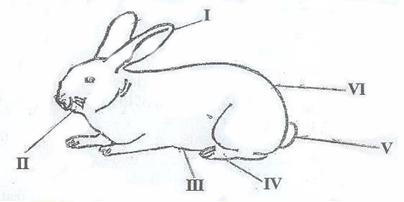1.
The S.I unit for measuring the work done by a force is
J.
K.
N.
W.
2.
The chemical formula of a compound describes the
number of molecules in the compound.
type of bonding in the compound.
ratio in which the elements are combined.
state of the compound.
3.
Which of the following life processes is represented by the equation glucose + oxygen → carbon dioxide + water + energy?
Digestion
Excretion
Photosynthesis
Respiration
4.
Each layer of soil profile is known as
horizon.
litter.
regolith.
solum.
5.
When the p-n junction of a transistor is reversed biased
current flows from the p-type to the n-type.
no current flows from the p-type to the n-type.
conduction of current occurs.
current flows from the n-type to the p-type.
6.
When a solid-liquid mixture is filtered, the liquid that separates out into the container is called
filtrate.
residue.
sediment.
solution.
7.
Which of the following processes involves the solid state of matter?
Boiling
Condensation
Evaporation
Melting
8.
Which of the following farming systems is most effective in maintaining soil fertility?
Crop rotation
Land rotation
Mixed cropping
Monoculture
9.
The disease in humans which is associated with insufficient intake of calcium is
goiter.
kwashiorkor.
rickets.
scurvy.
10.
The arrow in the circuit symbol of either n-p-n or p-n-p transistor is always on the
base lead.
collector lead.
emitter lead.
receiver lead.
11.
Which of the following insect pests of crops has piercing and sucking mouthparts?
Aphids
Grasshoppers
Stemborers
Termites
12.
A reflex action involves the
brain and muscles.
brain and nerves.
spinal cord and muscles.
spinal cord and nerves.
13.
The type of image formed in a plane mirror is always
diminished.
enlarged.
real.
virtual.
14.
Which of the following statements about acids are correct?
I. They turn red litmus paper blue
II. They can be classified as either organic or mineral acids
III. They can be neutralized by bases
I and II only
I and III only
II and III only
I, II and III
15.
A transistor is said to operate in an active region when
one p-n junction is forward biased and the other is reverse biased.
base-emitter junctions are reverse biased.
both p-n junctions are reverse biased.
base-collector junction is forward biased.
16.
Tuberculosis is spread
through eating of contaminated food.
when an infected person coughs openly into the air.
through shaking of hands of infected persons.
through sharing of contaminated syringes.
17.
One function of engine oil in the engine of a tractor is to
warm the engine.
enhance air intake.
ensure proper mixing of fuel.
lubricate the engine parts.
18.
Black pod is a disease of
cocoa.
coffee.
guava.
mango.
19.
The efficiency of a machine is always less than 100% because part of the energy input is used to
stop the machine after working.
perform useful work of the load.
overcome friction.
lift the machine up.
20.
Which of the following electronic components are used to produce oscillator circuits?
I. Transistor
II. Inductor
III. Capacitor
I and II only
I and III only
II and III only
I, II and III
21.
Which of the following sources of light is natural?
Filament bulb
Fluorescent tube
Glow worm
Fire cracker
22.
Which of the following substances are carried by the blood?
I. Hormones
II. Urine
III. Oxygen
IV. Carbon dioxide
I and III only
II and III only
I, II and IV only
I, III and IV only
23.
The practice of starting new organization in response to identified opportunities is termed
agribusiness.
business enterprise.
entrepreneurship.
management.
24.
The sub-atomic particle with zero charge in the nucleus of an atoms is called
electron.
ion.
neutron.
proton.
25.
Which of the following management practices greatly helps in record keeping?
Culling
Debeaking
Dehorning
Identification
26.
In a pin-hole camera, when the size of the pin-hole is increased, the image formed is
blurred.
erect.
magnified.
virtual.
27.
Non-reactive metals are preferred in making ornaments and jewellery because they
are attractive.
do not react with atmospheric oxygen.
do not retain their luster.
are corrosive.
28.
Producers in an ecosystem are plants that
attracts insects.
feed on other plants.
manufacture their own food.
trap insects.
29.
The use of resistant varieties of crop in controlling diseases is described as
biological control method.
chemical control method.
cultural control method.
physical control method.
30.
The chemical formula for aluminium oxide is represented as AlxOy. The values of x and y are respectively
3 and 2.
3 and 1.
1 and 3.
2 and 3.
31.
In electrical circuits, the component that protects appliances against high currents is the
capacitor.
fuse.
resistor.
switch.
32.
One benefit of technology to industrialization is
environmental pollution.
reduction in skilful labour
provision of machinery.
increase in cost of production of goods.
33.
Which of the following factors contribute to early parenthood?
I. Poverty
II. Illiteracy
III. Lack of parental care
IV. Peer pressure
I and II only
II and III only
III and IV only
I, II, III and IV
34.
Which of the following examples of fertilizers improves soil texture?
Compost
N.P.K.
Sulphate of ammonia
Urea
35.
The reaction between hydrochloric acid and sodium hydroxide produces
sodium oxide only.
sodium chloride only.
sodium oxide and water.
sodium chloride and water.
36.
In modern electrical wirings the colour code for the live wire is
blue.
brown.
green.
green and yellow.
37.
An example of soil minor nutrient is
calcium.
iron.
nitrogen.
phosphorus.
38.
The complete development of a human foetus in the womb normally takes
7 months.
8 months.
9 months.
10 months.
39.
A material that allows a small amount of light energy to pass through it but cannot be seen through is referred to as
opaque.
reflective.
translucent.
transparent.
40.
The lead of the transistor responsible for activation is the
amplifier.
base.
collector.
emitter.
a)
The diagrams below are illustrations of an experiment in the laboratory using a piece of stone, a cork of mass 4.0 g and other necessary materials.

The initial volume of water in A was read and noted. A string was attached to a piece of stone and the stone lowered gently into the water as shown in B. The volume was again read and noted. Finally, the cork of mass 4.0 g was attached to the stone and both materials lowered gently into the water as shown in C. The volume was read and noted.
i)
Why did the level of the water rise when the stone was lowered gently into it as shown in diagram B.
ii)
Why was it necessary to attach the stone to the cork before lowering it gently into the water as shown in diagram C?
iii)
What would have happened if the cork alone were lowered gently into the water?
iv)
What is the volume of the
α)
stone?
β)
cork?
v)
Calculate the density of the cork.
vi)
Why were the materials lowered gently in to the water?
b)
A salt solution was prepared in the laboratory using the set of apparatus illustrated below. Study the illustrations carefully and used them to answer the question that follow.

i)
Name each of the apparatus labelled I, II, III, IV and V.
ii)
State one function of each of the apparatus labelled I, II, III, IV and V.
c)
The diagram below is an illustration of the external features of a flowering plant.
Study it carefully and use it to answer the questions that follow.

i)
Name the parts labelled I, II, III, IV, V and VI.
ii)
State one function of each of the parts labelled I, II, III, V and VI.
iii)
State the two main parts of a flowering plant.
d)
The diagram below is an illustration of a small farm animal.

i)
Identify the animal.
ii)
Name each of the parts of the animal labelled I, II, III, IV, V and VI.
iii)
Name the structure in which the animal is kept.
iv)
Mention three breeds of the animal.
v)
State two management practices to be adopted in order to control diseases and pests in the rearing of the animal.
a)
i)
What is technology?
ii)
State one use of technology in communication.
b)
Write and balance each of the following chemical equations:
i)
Fe + O2 → Fe2O3;
ii)
Na + Cl2 → NaCl;
iii)
H2 + O2 → H2O.
c)
State one funtion of each of the following components of a typical cell:
i)
nucleus;
ii)
chloroplast;
iii)
mitochondrion.
d)
Mention four cultural practices in vegetable crop production.
e)
Name two agencies in food safety and quality assurance in Ghana.
(a)
Explain why a tomato plant is likely to wilt if too much fertilizer is applied to it.
(b)
(i)
Give two differences between electrical insulators and electrical conductors.
(ii)
State two effects of illegal electrical connections in the home.
(c)
Explain each of the following terms as used to describe change of state of matter:
(i)
condensation;
(ii)
freezing.
(d)
(i)
State two diseases of the circulatory system in humans.
(ii)
Mention two ways in which each of the diseases you have stated in (d)(i) can be prevented.
a)
i)
What is a transistor?
ii)
Give two uses of a transistor.
b)
Mention the suitable solvent for each of the following solutes:
i)
grease;
ii)
ink stain;
iii)
starch;
iv)
cube sugar;
v)
oil paint;
vi)
iodine.
c)
i)
What is a respiratory organ?
ii)
Name two structures of the respiratory system of humans.
d)
i)
What is agricultural chain?
ii)
Name two types of agricultural chain.
a)
i)
What are stars?
ii)
Arrange in order, starting from the sun, the first four planets in the solar system.
b)
State
i)
two differences between plants and animals;
ii)
two similarities between plants and animals.
c)
Explain each of the following farming systems:
i)
pastoral farming;
ii)
ecological farming.
d)
State the properties of water in terms of
i)
odour,
ii)
taste,
iii)
effect on litmus.
a)
What are
i)
annual plants?
ii)
perennial plants?
b)
Mention one danger involved in each of the following activities in the laboratory:
i)
eating or drinking water in the laboratory;
ii)
washing hands with unknown liquid in a beaker;
iii)
walking barefooted.
c)
i)
What is a digestive enzyme?
ii)
Give two examples of digestive enzymes in humans.
d)
Give two differences between conduction and radiation of heat.